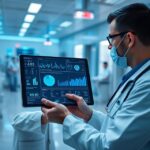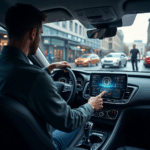How Data Science is Changing the Transportation and Logistics Industry
Introduction
The transportation and logistics industry plays a huge role in keeping the global economy running. From freight shipping to ride-hailing services, it’s a complex network that relies on speed and efficiency. Recently, data science has become a game-changer, improving everything from route planning to vehicle maintenance, and even changing how goods are delivered and how we travel.
With all the data coming from vehicles, shipments, and even customer interactions, data science is opening up new possibilities. Whether it’s cutting costs, speeding up deliveries, or making the industry more sustainable, the impact is huge.
Data Science in Route Optimization
One of the biggest challenges in transportation is making sure deliveries happen as quickly and efficiently as possible. In the past, companies relied on fixed routes and estimated travel times. But with the amount of data available today, they can now make smarter, real-time decisions.
How It Works:
Logistics companies now use data to track real-time traffic, weather, delivery history, and GPS information. Machine learning algorithms process this data to predict the best and most cost-effective routes, factoring in things like traffic jams, road conditions, and construction zones.
Example:
Companies like UPS and FedEx are already using data science for route optimization. UPS uses a system called ORION, which saves millions of miles and reduces fuel costs by finding the most efficient delivery routes.
Benefits:
- Faster Deliveries: Less time spent on the road means more deliveries can be made.
- Cost Savings: Lower fuel costs and less wear on vehicles.
- Environmental Benefits: More efficient routes mean fewer emissions.
Predictive Maintenance and Fleet Management
For businesses with large fleets of vehicles, keeping those vehicles in good condition is crucial. Traditionally, maintenance schedules were set on a fixed timeline, but with data science, we can predict when a vehicle will need maintenance before it breaks down.
How It Works:
Sensors installed in vehicles collect data on things like engine temperature, tire pressure, and brake wear. This data is analyzed to predict when maintenance is needed, so companies can avoid costly breakdowns and downtime.
Example:
Tesla and Caterpillar are leaders in predictive maintenance. Tesla uses data from its electric vehicles to predict when a car will need servicing and even schedules appointments automatically for drivers.
Benefits:
- Reduced Downtime: Avoid unexpected breakdowns and repairs.
- Cost Efficiency: Replace parts only when necessary, not on a fixed schedule.
- Longer Vehicle Lifespan: Timely maintenance means vehicles last longer.
Supply Chain Optimization Using Data Science
Transportation is just one part of the supply chain puzzle. The entire supply chain—from manufacturers to consumers—relies on precise coordination. Data science is helping optimize this whole process, making inventory management smoother and reducing delays.
How It Works:
With machine learning and big data analytics, companies can predict demand patterns, adjust inventory levels, and optimize warehouse operations. Data science can even spot demand fluctuations based on things like seasonal trends and social media.
Example:
Walmart and Amazon are using data science to streamline their supply chains. Amazon, for example, uses algorithms to predict which products will be in high demand and places them in warehouses closer to customers, speeding up delivery.
Benefits:
- Faster Deliveries: Products get to consumers quicker by reducing delays.
- Inventory Efficiency: Less chance of overstocking or running out of items.
- Cost Reduction: Streamlined procurement and reduced waste.
Data Science in Ridesharing and Public Transport
Data science isn’t just transforming logistics—it’s also changing how we travel. In ridesharing and public transport, data science is improving route planning, predicting demand, and enhancing the customer experience.
How It Works:
Ridesharing companies like Uber and Lyft use data to predict where and when riders will need a ride, optimize driver assignments, and reduce wait times. Public transportation systems also use data to analyze traffic patterns, adjust schedules, and predict how crowded buses or trains will be.
Example:
Uber’s dynamic pricing model is a great example. By analyzing factors like weather, location, time of day, and the number of available drivers, Uber adjusts prices in real-time to balance supply and demand.
Benefits:
- Better User Experience: Shorter wait times and better route matching.
- Cost Efficiency: Fair prices for riders and optimized routes for drivers.
- Sustainability: Ridesharing and smart public transport reduce the number of cars on the road, lowering emissions.
Data Science and Autonomous Vehicles
One of the most exciting advancements in transportation is autonomous vehicles (AVs), which rely heavily on data science. From self-driving trucks to autonomous taxis, data science is the driving force behind this technology.
How It Works:
Autonomous vehicles use a combination of sensors, cameras, and machine learning algorithms to make decisions about things like navigation and safety. The car constantly collects and processes data to respond to changes in its environment in real-time.
Example:
Companies like Waymo (a subsidiary of Alphabet) and Tesla are leading the way in self-driving technology. Waymo’s cars use massive amounts of data to safely navigate cities, while Tesla’s Autopilot improves continuously by collecting data from thousands of vehicles on the road.
Benefits:
- Increased Safety: Removing human error reduces accidents and injuries.
- Cost Savings: Reduces the need for human drivers, lowering labor costs.
- Sustainability: Autonomous vehicles can drive more efficiently, cutting down on fuel use.
The Future of Data Science in Transportation
The future of transportation is tightly linked to data science. As technologies like 5G, AI, and the Internet of Things (IoT) develop, the transportation and logistics industry will become even more connected, efficient, and eco-friendly. Data science will continue to drive innovation, making transportation faster, cheaper, and more sustainable.
Conclusion
Data science is transforming the transportation and logistics industry in incredible ways. By using real-time data, predictive analytics, and machine learning, companies are becoming more efficient, cutting costs, and improving customer experiences. As data science evolves, we can expect even more exciting advancements that will change how people and goods move around the world.







